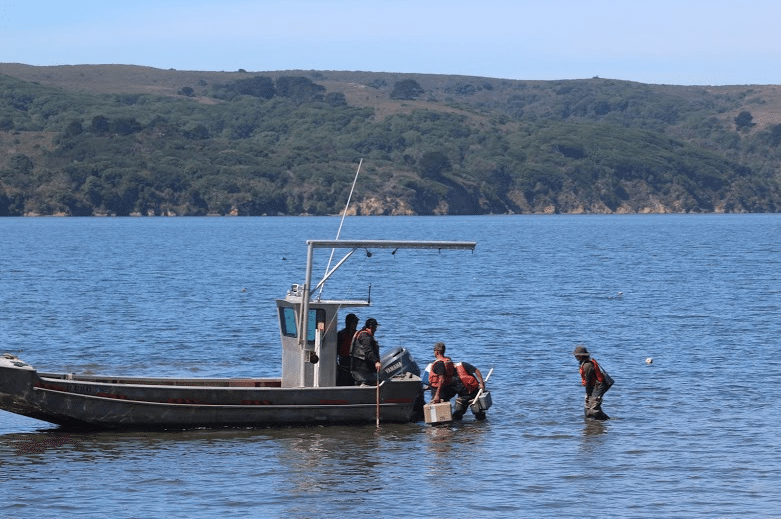by Kathleen Willett
Every summer, recreational oyster and shellfish harvesters brace themselves for the period from May until the end of October when red tides prohibit the recreational harvesting of shellfish from coastal waters all along the California coast.
Meanwhile, intrepid kayakers eagerly plan moonless night paddles to view the spectacular marine bioluminescence during the same period. It turns out that the same family of algae is responsible for both phenomena.
Red tides, or Harmful Algal Blooms (HABs, as scientists prefer to call them,) occur when colonies of phytoplankton, a form of algae, “bloom” or begin reproducing so rapidly, the result is millions of cells per gallon of water. As the name implies, the bloom often turns the water red as a result of the pigment present in each algal cell for sunlight capture, which is necessary for cell growth.
Phytoplankton is present in ocean waters throughout the year, but blooms occur only when ocean temperatures and salinity are favorable, usually in the months of May through October on the northern California coast.
But that may be changing.
The Pacific Ocean is a vast body of water with a relatively constant temperature that moderates climate and has provided a stable habitat for marine life for millennia. Could the ocean along the Marin and Sonoma coasts actually be getting warmer as the climate change believers would have us think? And if so, does warmer water have an effect on the red tides?
According to the UC Davis Bodega Marine Laboratory, the seawater along the Sonoma and Marin coasts is getting warmer. The Bodega Ocean Observing Node, or BOON, is a coastal ocean observing system centered at the Bodega Marine Lab. It has been tracking ocean temperatures along our coast for decades.
Ocean temperature at the Bodega Marine Lab in late August, 1988, as reported on the BOON website, was 58.1 degrees Fahrenheit. The temperature has trended upward ever since. At the same location and the same time of year—August 30, 2015—the temperature was 61.8 degrees Fahrenheit.
A 3.7-degree gain is significant and troubling. In warmer waters, algal blooms will begin sooner and persist longer, and with this longer growing season, the blooms may begin to produce biochemicals not previously seen.
Dinoflagellates, the type of single-celled phytoplankton responsible for the amazing bioluminescence that the kayakers hope to see, also produce a biotoxin called saxitoxin, which has been the primary concern during red tide season. Saxitoxin accumulates in filter feeders such as mussels, oysters and other shellfish. Paralytic Shellfish Poisoning (PSP), which can be fatal to humans as well as marine life, is caused by ingestion of saxitoxin.
According to the Alaska Department of Health and Social Services, Division of Public Health, saxitoxin is 1,000 times more potent than cyanide. And PSP toxins are not destroyed by heating or freezing, so cooking contaminated shellfish does not make it safe to eat.
The California Department of Public Health (CDPH) ensures with thorough, regular testing that all commercially available oysters and other shellfish are safe for human consumption year-round. But recreationally harvested oysters and shellfish can be very high-risk.
Historically, PSP was the problem during red tide season. But in 1998, the Marine Mammal Center in Marin County diagnosed the first case of domoic acid poisoning in marine mammals. Sentinels for potentially dangerous environmental changes in the ocean environment, sick and stranded marine mammals warn us of changing ocean conditions.
Domoic acid is a biotoxin produced by diatoms, another type of single-celled algae which blooms as seawater warms. Domoic acid causes Amnesic Shellfish Poisoning (ASP) as it accumulates in shellfish, sardines and anchovies—which may then be eaten by larger marine mammals.
On August 26, 2015, the CDPH issued a warning to consumers in Humboldt and Del Norte counties not to eat bivalve shellfish due to detection of dangerous levels of domoic acid. The same warning is already in place for Santa Cruz, Monterey and Santa Barbara counties. According to Dr. John Largier, Professor of Coastal Oceanography at the Bodega Marine Lab, it is very possible that the same warning may be issued for Marin and Sonoma counties in the next month or so.
“The Mendocino, Sonoma and Marin county coastal waters will become warmer in the next few weeks to a month as our cool ocean upwelling system weakens,” says Dr. Largier, “and it is very likely that the diatoms will then begin to bloom and the same warning will be issued here as well.”
There may also be a third biotoxin, previously not present in significant concentrations on the north coast. Dr. Raphael Kudela, professor of Ocean Sciences at UC Santa Cruz, studies phytoplankton ecology. According to Dr. Kudela, “Okadaic acid, which causes Diarrhetic Shellfish Poisoning (DSH), may become a problem as our coastal waters continue warming and we begin to see more temperature gradient stratification.”
Produced by several species of dinoflagellates, okadaic acid also accumulates in shellfish.
With warmer ocean temperatures, algal blooms will occur earlier and persist longer.
Is it possible that red tides could last all year on the north coast? Will there be a recreational shellfish harvest on the Marin and Sonoma coasts in 20 years—or even in 10 years if ocean temperatures continue to climb?
And then there is the commercial oyster industry here in Tomales Bay. One wonders how the commercial oyster industry—already grappling with the serious onslaught to their industry that ocean acidification presents—will cope with the potential increased temperatures and presence of multiple biotoxins in the coastal ocean environment.
As one climatologist put it, “This may be a dress rehearsal for climate change.”












